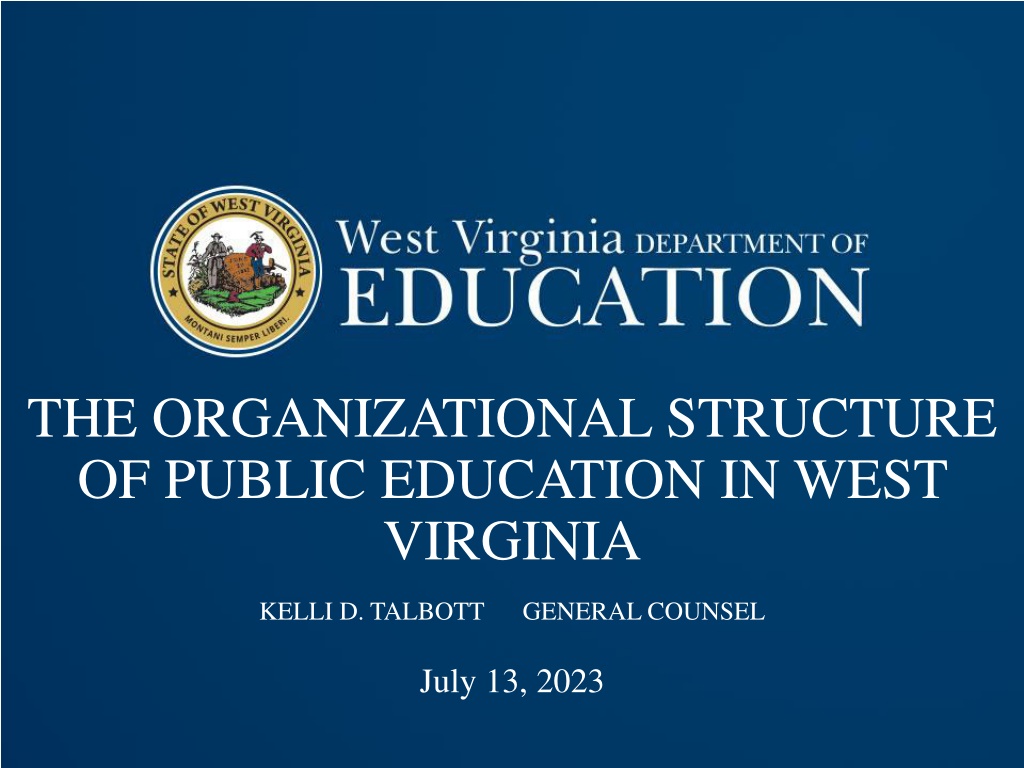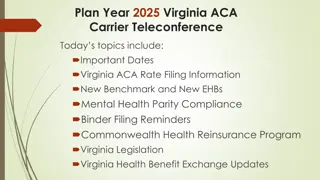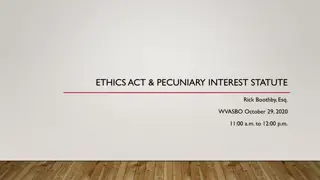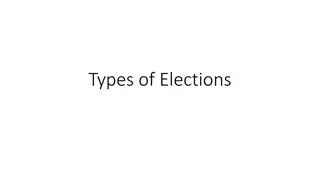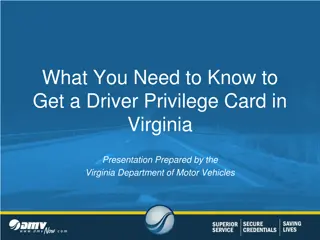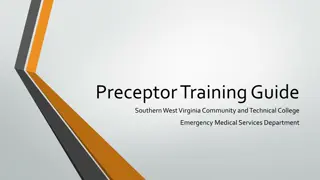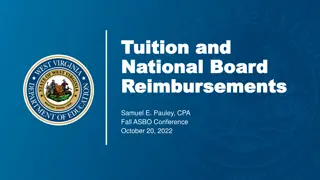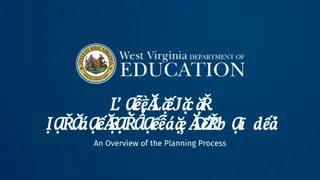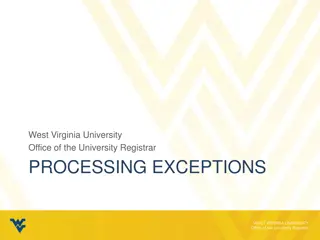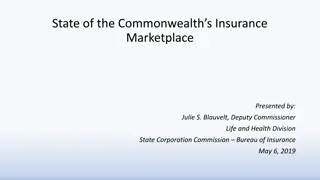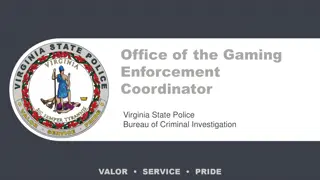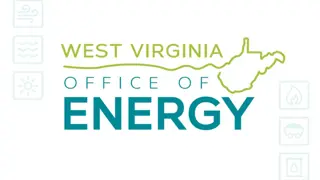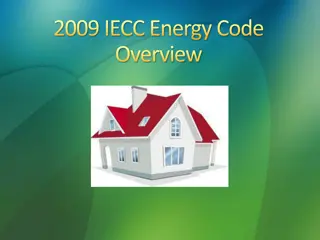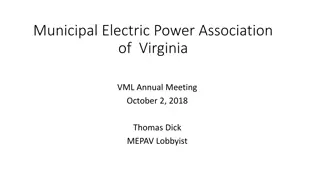The Organizational Structure of Public Education in West Virginia
The West Virginia Board of Education's status within the government structure, legal powers under the state constitution, and relationships with other public entities, including county boards of education, are outlined. The significance of the education clause in West Virginia's Constitution, dating back to its founding in 1863, is explored along with historical context linked to the lack of public education in Virginia post-Civil War. The state's commitment to a thorough and efficient system of free schools is emphasized.
Download Presentation

Please find below an Image/Link to download the presentation.
The content on the website is provided AS IS for your information and personal use only. It may not be sold, licensed, or shared on other websites without obtaining consent from the author. Download presentation by click this link. If you encounter any issues during the download, it is possible that the publisher has removed the file from their server.
E N D
Presentation Transcript
THE ORGANIZATIONAL STRUCTURE OF PUBLIC EDUCATION IN WEST VIRGINIA KELLI D. TALBOTT GENERAL COUNSEL July 13, 2023
THE WEST VIRGINIA BOARD OF EDUCATION S STATUS Where does the State Board fit in the organizational scheme of government? What are the State Board s legal powers under the West Virginia Constitution and other West Virginia law? What are the legal relationships between the State Board and other public entities including the county boards of education?
At the core of these questions is the West Virginia Constitution. 3
Article XII, Section 1Education The legislature shall provide, by general law, for a thorough and efficient system of free schools. 4
Why did West Virginia put that in our Constitution? In 1863, when West Virginia became a state, our founders in the Western Counties of what was then part of Virginia, had longstanding grievances with the Eastern Counties over the lack of a public education system. The leaders in the Eastern Counties didn t want a public education system. They wanted education to be limited to those who could afford to pay for a private education which perpetuated a class system. The Western Counties, whose inhabitants were generally less wealthy, couldn t afford to privately educate their children and grew to resent the lack of a public education system. 5
The public education clause was in West Virginia s Constitution when West Virginia was admitted to the Union in 1863. 6
Meanwhile, In Virginia . . . After the Civil War, in 1867, Congress passed legislation setting out conditions that the Southern states had to meet to be readmitted to the Union. Virginia was one of those Southern states. By 1870, Virginia had not been readmitted to the Union. It was one of three states the other two being Mississippi and Texas who had not satisfied the conditions to be readmitted. Congress passed legislation requiring all three of these states to include public education provisions in their constitutions as a condition of being readmitted to the Union. In the Congressional Act admitting Virginia to the Union, Congress specifically stated that the constitution of Virginia shall never be so amended or changed to deprive any citizen . . . of the school rights and privileges secured by the constitution of said State. 7
Article XII, Section 2Supervision of Free Schools The general supervision of the free schools of the State shall be vested in the West Virginia board of education which shall perform such duties as may be prescribed by law. . . . 8
Article XII, Section 2Supervision of Free Schools The board shall consist of nine members to be appointed by the governor, by and with the advice and consent of the senate, for overlapping terms of nine years, except the original appointments shall be for terms of one, two, three, four, five, six, seven, eight, and nine years, respectively. No more than five members of the board shall belong to the same political party, and in addition to the general qualifications otherwise required by the Constitution, the legislature may require other specific qualifications for membership on the board. No member of the board may be removed from office by the governor except for official misconduct, incompetence, neglect of duty, or gross immorality, and then only in the manner prescribed by law for the removal by the governor of state elected officers. . . . 9
Article XII, Section 2Supervision of Free Schools The West Virginia board of education shall in the manner prescribed by law, select the state superintendent of free schools who shall serve at its will and pleasure. He shall be the chief school officer of the State and shall have such powers and shall perform such duties as may be prescribed by law. The state superintendent of free schools shall be a member of the board of public works as provided by subsection B, section fifty-one, article six of this Constitution. 10
HISTORICAL PERSPECTIVE ON THE CONSTITUTION Article XII, Section 2 was amended into the West Virginia Constitution in 1958. This section of the Constitution establishes the State Board and the State Superintendent as constitutional officers who do not owe their existence to any other body of government. 11
STATE EXECUTIVE BRANCH ORGANIZATION CHART 12
HISTORICAL PERSPECTIVE ON THE CONSTITUTION Prior to 1958, the State Superintendent was elected to office. Prior to 1958, the State Board of Education was a creature of statute and its authority was in large part, subordinate to that of the State Superintendent regarding public education. The 1958 amendment grew out of a study commissioned by the Legislature that recommended the amendment to remove partisan politics from public education, as much as possible. 13
HISTORICAL PERSPECTIVE ON THE CONSTITUTION In 1989, Governor Gaston Caperton spearheaded a proposal to take the State Board s and State Superintendent s constitutional status away. 14
HISTORICAL PERSPECTIVE ON THE CONSTITUTION In 1989, the Education Reorganization Amendment was on the ballot for a decision by the voters. To amend the state Constitution so as to eliminate the office of the state superintendent of free schools as a constitutional office and the West Virginia board of education as a constitutional board, and to vest the responsibility for the exercise and performance of the powers and duties of the state superintendent and state board in such department of state government or person as shall be prescribed by law. The proposed amendment was defeated by a vote of 29,776 for to 220,286 against. 15
School Districts Under the Constitution In the 1863 Constitution, the Legislature had exclusive authority to create school districts, which meant it could carve out a new district from an existing district at any time. In 1872, the Constitution was amended to require a vote of the affected citizens in any circumstance in which a new school district was proposed to be created out of an existing district or districts. Under this school district organizational structure, West Virginia had over 450 school districts dominated by very small schools and small districts. 16
School Districts In 1933, the Legislature passed legislation to make school districts follow county territory lines. 17
COUNTY SUPERINTENDENTS In the 1863 Constitution, each county was required to have a County Superintendent, who was required to be elected. This was changed in the 1872 Constitution which stated that the Legislature could provide for the establishment of County Superintendents to be selected as the Legislature saw fit. However, in the wake of the 1872 amendment to the Constitution, the Legislature did not make County Superintendents appointed until around the early 1940s. 18
COUNTY BOARDS OF EDUCATON Before West Virginia had a county school district system, the boards of education for the various school districts within a county were appointed by the County Superintendent. That system evolved into one in which school district presidents were elected and the remainder of the members of the board were appointed by the County Superintendent. In 1986, the Legislature passed a resolution to put a measure on the ballot to amend Article XII, 6 of the West Virginia Constitution which is the School Districts clause of the Constitution. The amendment, which passed, enshrined into the West Virginia Constitution that county board members are elected on a non-partisan basis and that no more than two of the members can be residents of the same magisterial district within a school district. 19
HOW HAVE THE COURTS DEFINED THE STATE BOARD S CONSTITUTIONAL AUTHORITY? Generally speaking, the courts have rendered an expansive interpretation to the State Board s constitutional authority to generally supervise the public schools. The State Board has broad supervisory authority over county school systems. 20
PUBLIC EDUCATION IS A FUNDAMENTAL CONSTITUTIONAL RIGHT Pauley v. Kelly (1979) and Pauley v. Bailey (1984) (West Virginia Supreme Court) Lincoln County parents brought class action alleging that school children were being denied a thorough and efficient education as a result of discriminatory mechanism for financing State s education system. The Supreme Court held that education is a fundamental constitutional right in West Virginia. The Supreme Court held that the State Board and State Superintendent have a duty to ensure the delivery and maintenance of a thorough and efficient system of free schools. 21
WHY IS PAULEY IMPORTANT? Pauley established that the delivery of a thorough and efficient education is ultimately the responsibility of the State. Pauleyled to the school funding formula or Public School Support Plan that is contained in statute, West Virginia Code 18-9A-1 et seq. The purpose of the Public School Support Plan is to provide a basic foundation financial support plan to ensure a more equitable educational opportunity for all children regardless of where they may live. 22
The Public School Support Plan (PSSP) In West Virginia Education Ass n v. Legislature of West Virginia, (1988), the Supreme Court held that the PSSP, is an integral part of the fundamental constitutional command that the Legislature provide for a thorough and efficient system of public education. The Legislature in specifying the basic foundation program contained in article nine A has established public policy which is presumed to vindicate the constitution. That body has made a determination that presumes this basic foundation program is a necessary part of fulfilling that constitutional obligation. Accordingly, a budget that does not include appropriations necessary to meet the mandates of the Public School Support Plan is unconstitutional. 23
STATE BOARD POLICY When the State Board was made a constitutional body in 1958, part of the design was to enable the State Board to make educational policy, independent of the Legislature that would have the force of law. In 1988, the Legislature passed a statute that purported to require the State Board to get legislative approval to enact policy/rules The State Board challenged the statute as an unconstitutional usurpation of its authority to generally supervise the public schools. 24
STATE BOARD POLICY West Virginia Board of Education v. Hechler (1988) Supreme Court held that rule-making by the State Board is within the meaning of general supervision of state schools, vested in the Board under the State Constitution. Supreme Court held that the statute which purported to require Legislative approval of the State Board s rules was unconstitutional inasmuch as it interfered with the State Board s constitutional authority. Supreme Court held that the statute s attempt to allow the Legislature to undertake the State Board s general supervisory powers violated the separation of powers doctrine. 25
STATE BOARD POLICY In 2022, the Legislature passed a Resolution to put a measure on the ballot to amend Article XII, 2 of the West Virginia the clause giving general supervision of the public schools to the State Board to require the State Board to submit its rules/policies to the Legislature for review, approval, rejection, or modification. The measure was on the November 8, 2022 ballot and was defeated by a vote of 275,683 to 200,791 57.86% against, 42.14% for. 26
STATE BOARD POLICY Because State Board Policy is an exercise of the State Board s constitutional authority, county boards of education are required to adhere to it. 27
STATE BOARD POLICY The West Virginia Supreme Court has upheld the State Board s policymaking authority in several cases. 28
STATE BOARD POLICY Bailey v. Truby (1984) State Board adopted a rule that required students to maintain a 2.0 GPA to participate in nonacademic extracurricular activities. Supreme Court held that the rule was a legitimate exercise of the State Board s general supervision authority under the State Constitution. 29
STATE BOARD POLICY Board of Education of County of Kanawha v. West Virginia Board of Education (1990) Kanawha County Board of Education sued State Board when it rejected the county s school closure/consolidation plan involving South Charleston Junior High School. The Supreme Court held that the State Board had the power and authority to reject the county s plan because it is authorized to take the steps necessary to fulfill its obligation to achieve the constitutionally mandated educational goals of quality and equality. The Supreme Court held that county boards of education do not have unlimited power to make final decisions on school closings and consolidation. 30
STATE BOARD POLICY Nicholas County Board of Education v. West Virginia Board of Education (2017) -In 2017, the NCBOE sued the WVBE in Kanawha County Circuit Court when the WVBE refused to approve an amendment to the NCBOE s CEFP seeking to consolidate high schools. - NCBOE argued that because it had met the minimum requirements for a CEFP amendment, the WVBE had to approve the amendment. - Supreme Court reaffirmed that WVBE has broad authority to generally supervise the schools in this State and held that it had the discretion to consider more than the minimum qualifications for approval of a CEFP amendment. 31
STATE BOARD POLICY WV Fed. of Teachers, et al. v. WVDE, et al. and WVEA, et al. v. WVDE, et al. (Cir. Ct. of Kan. Co., Jan. 2021) - Teachers sued claiming that the return to in-person instruction during the COVID-19 pandemic was unconstitutional in violation of the thorough and efficient education clause insofar as it was allegedly not safe to do so and that WVBE s decision to return to in-person instruction encroached upon local control of county boards of education. - Circuit Court held that the WVBE s decision to require return to in-person instruction was within its constitutional authority. 32
WAIVER OF STATE BOARD POLICIES The WVDE s website contains information and forms for requesting a waiver of WVBE Policies. All waiver requests must be approved by a majority vote of the WVBE at a public meeting. 33
QUESTIONS? 34
